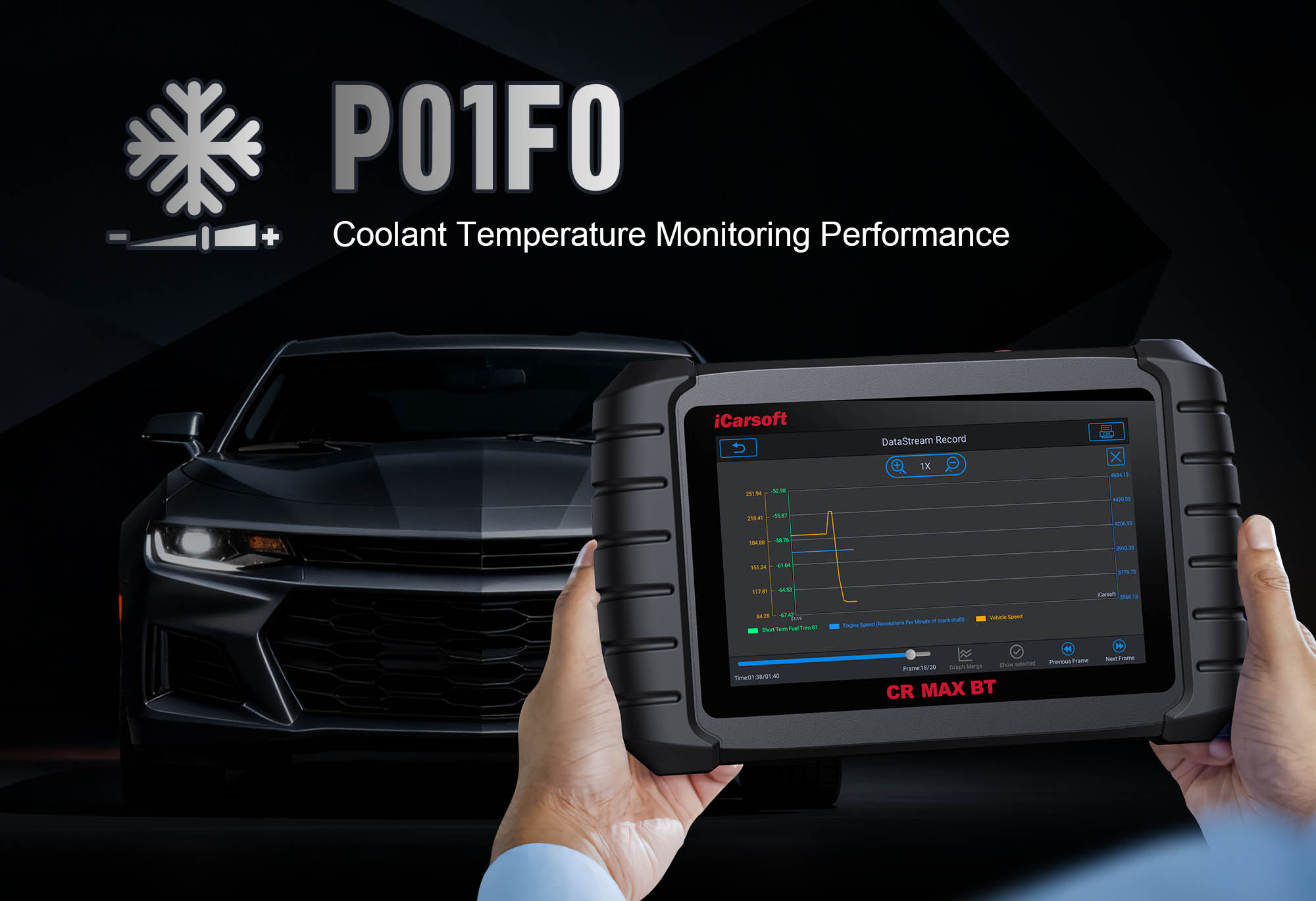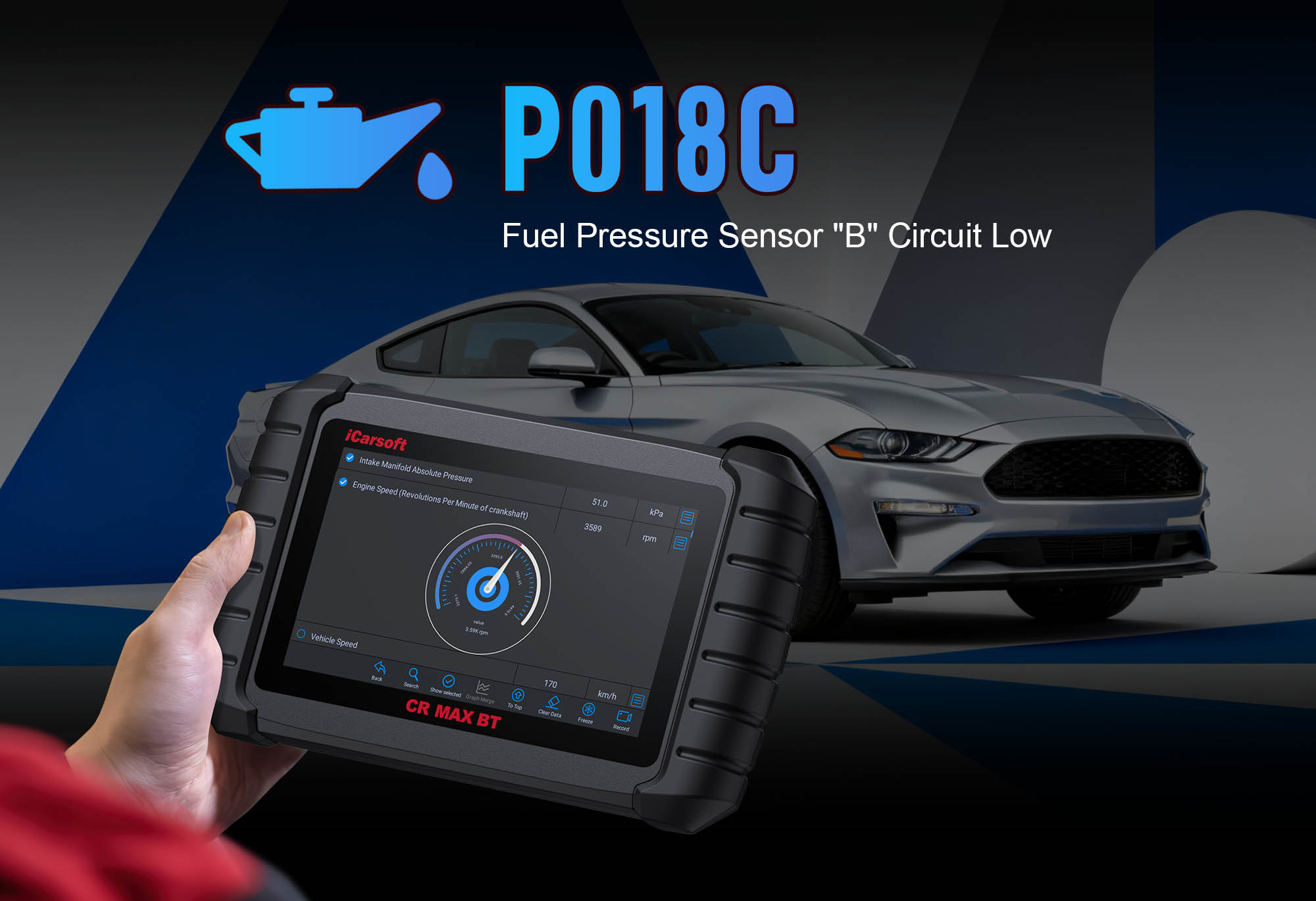Diagnose & Clear P2118 with iCarsoft CR Ultra P
If your vehicle suddenly drops into idle while driving, displays a "reduced power" warning, or triggers a check engine light with no obvious mechanical issue, a diagnostic scan will likely return P2118. This OBD-II code stands for "Throttle Actuator Control System - Forced Idle"—a critical fault indicating the Engine Control Module (ECM) has intentionally locked the throttle at idle to protect the engine from potential damage. The electronic throttle body (throttle actuator) regulates airflow based on driver input, and when the ECM detects a dangerous malfunction (e.g., erratic signals or uncommanded movement), it forces the throttle to idle as a safety measure.
Basic scanners might only flag a "throttle system error" but can’t pinpoint why the ECM forced idle, test actuator stability, or recalibrate the system—leaving you guessing between sensor glitches, wiring issues, or a failing throttle body. The iCarsoft CR Ultra P, with its OE-level engine diagnostics, bi-directional controls, and real-time signal analysis, solves this. Let’s break down how to diagnose and resolve P2118 with precision, using the CR Ultra P’s unique features to restore throttle control and eliminate forced idle.
Understanding P2118: Causes & Key Symptoms
The electronic throttle body relies on a closed-loop system: the ECM sends commands to the throttle motor, while throttle position sensors (TPS 1 and TPS 2) feed back the actual plate position. P2118 triggers when the ECM detects a critical mismatch—for example, the throttle plate moves unexpectedly, or sensor signals indicate a potential runaway condition. To prevent engine damage or unsafe acceleration, the ECM forces the throttle to idle (typically 600–800 RPM), overriding driver input.
Key Symptoms of P2118
-
Sudden Forced Idle: The engine drops to idle while driving, even with the gas pedal pressed—often at highway speeds, risking accidents.
-
Reduced Power Warning: A dashboard alert (e.g., "Engine Power Reduced" or "Throttle Control Fault") activates alongside the check engine light.
-
Unresponsive Throttle: Pressing the gas pedal has no effect; the engine remains at idle.
-
Intermittent Faults: Symptoms may appear and disappear, especially in cold weather or under heavy electrical load (e.g., using AC and headlights).
-
Stalling Risk: In severe cases, the engine may stall after forcing idle, leaving the vehicle immobile.
Common Causes of P2118
|
Cause
|
Description
|
|
Faulty Throttle Position Sensors (TPS)
|
Mismatched signals from TPS 1 and TPS 2 (e.g., one reads 1V, the other 4V at idle) trigger the ECM’s safety protocol.
|
|
Throttle Actuator Motor Intermittent Failure
|
The motor works occasionally but stalls or sends erratic position data, confusing the ECM.
|
|
Wiring/Electrical Issues
|
Loose connectors, corroded pins, or frayed wires cause intermittent signal drops between the throttle body and ECM.
|
|
Dirty Throttle Body
|
Carbon buildup on the throttle plate creates friction, leading to uncommanded movement or slow response.
|
|
ECM Software Glitch
|
Rarely, outdated or corrupted ECM firmware misinterprets sensor data, falsely triggering forced idle.
|
Why iCarsoft CR Ultra P Excels at Diagnosing P2118
Intermittent faults and safety-triggered idle make P2118 challenging, but the CR Ultra P’s specialized features target these issues:
Real-Time Signal Analysis
Monitors TPS 1/TPS 2 voltages, throttle position, and ECM commands simultaneously, capturing intermittent mismatches that basic tools miss.
Bi-Directional Actuator Stress Testing
Activates the throttle motor under varying loads (e.g., cold start, high electrical demand) to replicate conditions that trigger forced idle.
Throttle Body Adaptation Relearn
Resets the ECM’s throttle position memory, critical for resolving false faults caused by sensor drift.
Topology Mapping
Visualizes the entire throttle circuit (sensors, motor, wiring, ECM) as a color-coded diagram, highlighting loose connections or corrosion.
Global Vehicle Coverage
Supports 200+ brands (Ford, Toyota, BMW, Audi, etc.) and engine types, including 2018+ models with DoIP/CAN-FD protocols.
41 Hot Service Functions
Includes ECM reset, throttle calibration, and sensor validation—essential for restoring trust between the ECM and throttle system.
Battery Tester Module
Verifies battery voltage and alternator output, ruling out low-voltage-related erratic throttle signals.
Step-by-Step: Diagnose P2118 with iCarsoft CR Ultra P
-
Safety First & Initial Checks
1. Pull Over Safely: If forced idle occurs while driving, pull over immediately to avoid accidents.
2. Let the Engine Cool: Wait 1–2 hours after driving to prevent burns when inspecting the throttle body.
3. Check Battery & Charging System: Use the CR Ultra P’s Battery Tester Module to verify voltage (12.4–12.7V) and alternator output (13.5–14.5V). Low voltage can cause erratic throttle signals.
4. Locate components via Component Location > Engine > Throttle Actuator System: Throttle body (intake manifold), TPS sensors (integrated in throttle body), and wiring harness.
-
Connect the CR Ultra P & Confirm P2118
Plug the CR Ultra P into the OBD-II port, power it on, and pair with the CR Link VCI (auto-connected via Bluetooth). Select AutoVIN Identify—the tool retrieves your engine type, throttle actuator specs, and ECM protocol. Navigate to Engine > Fault Codes > Read Codes to confirm P2118. Tap Code Details for insights (e.g., "Ford Escape: Throttle Actuator Control System Forced Idle; TPS 1/TPS 2 Mismatch > 0.5V; Check Wiring or Sensors"). Note related codes (e.g., P2104, P2110) and resolve P2118 first.
-
Analyze Live Data for Signal Mismatches
1. Go to Engine > Live Data > Throttle Control System and select parameters: TPS 1 Voltage, TPS 2 Voltage, Throttle Plate Position (%), ECM Command to Throttle Motor.
2. Start the engine and let it idle. Normal readings: TPS 1 (0.5–1.0V), TPS 2 (4.0–4.5V, summing to ~5V), Plate Position (10–15%), Stable "Idle" motor command.
3. Test under load (turn on AC, headlights) and gently press the gas pedal. Watch for: TPS 1/TPS 2 mismatch (>0.5V) = sensor fault; Plate position not matching ECM command = actuator motor issue.
-
Test Throttle Actuator & Circuit
1. Bi-Directional Stress Test: Go to Engine > Special Functions > Throttle Actuator Control > Stress Test. The tool cycles the throttle from idle to 50% open repeatedly—no smooth movement = motor or throttle plate issue.
2. Sensor Resistance Test: Turn off ignition, disconnect throttle body connector. Set tool to "Ohms" and probe TPS 1/TPS 2 pins. Resistance should rise smoothly with manual plate movement; jumps/drops = faulty sensor.
3. Wiring Continuity Check: Use the tool’s "Continuity Test" to check wires between throttle body and ECM—beep confirms continuity; no beep = broken wire.
-
Repair or Service to Fix P2118
- Throttle Body Cleaning: Remove air intake hose, spray cleaner on plate/housing, wipe buildup. Reinstall and run Throttle Adaptation Relearn.
- Throttle Body Replacement: Replace faulty unit with OEM-compatible part (e.g., Dorman 977-014 or Bosch 0280750517); run Throttle Calibration.
- Wiring/Connector Repairs: Fix frayed wires with heat-shrink tubing; clean corroded connectors with contact cleaner and apply dielectric grease.
- ECM Reset & Software Update: Use ECM Reset to clear faults; check firmware updates via One-Key Upgrade for 2018+ models.
-
Clear P2118 & Validate the Repair
1. Clear the Code: Reconnect the CR Ultra P, go to Engine > Fault Codes > Clear Codes, confirm P2118 deletion.
2. Test Drive for Stability: Drive 30–40 miles, testing acceleration, idle, and load operation (AC, headlights). Ensure no forced idle or unresponsive throttle.
3. Post-Repair Validation: Run Engine > System Check—"No Faults Detected" confirms reliability.
4. Save Report: Document via History & Report for future reference.
Preventing P2118 Recurrence
-
Quarterly Throttle Checks: Use the CR Ultra P to test TPS signals and motor response—catch sensor drift early.
-
Regular Cleaning: Clean the throttle body every 30,000 miles to prevent friction-related position errors.
-
Connector Maintenance: Inspect throttle/ECM connectors every 15,000 miles—tighten loose connections and remove corrosion.
-
Software Updates: Keep the CR Ultra P updated via One-Key Upgrade to access the latest ECM calibration tools.
Conclusion
P2118’s forced idle is a dangerous safety feature triggered by throttle system faults. The iCarsoft CR Ultra P turns guesswork into precision with real-time signal analysis, stress testing, and adaptation relearn, ensuring you fix the root cause—whether mismatched sensors, a failing motor, or wiring issues.
With 200+ brand coverage and 41 service functions, the CR Ultra P is more than a P2118 fix—it’s a long-term investment in safe, reliable driving. Restore throttle control, eliminate forced idle, and drive with confidence—all with one professional-grade diagnostic tool.





